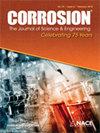Research on Pitting Corrosion of Micro-alloyed High Strength Steel Bars
IF 1.1
4区 材料科学
Q4 MATERIALS SCIENCE, MULTIDISCIPLINARY
引用次数: 0
Abstract
In this study, a series of soaking experiments were conducted in simulated marine environment solution to explore the pitting corrosion behavior induced by four types of inclusions in micro-alloyed steel bars: Al2O3, MnS, Al2O3-(Ti,V,Nb)N and Al2O3-MnS-(Ti,V,Nb)N. In the early stage of corrosion, due to the high-density lattice distortion zone around the MnS and Al2O3 inclusions, along with the fact that these inclusions are not closely connected with the steel matrix, micro-cracks can occur leading to the initial corrosion of MnS in the Cl- environment. The corrosion rate of Al2O3 is the second highest after MnS, and clusters of Al2O3 can further accelerate the corrosion rate. The lattice distortion density around (Ti, V, Nb)N precipitates is significantly lower than that around MnS and Al2O3 inclusions. Additionally, (Ti, V, Nb)N is closely connected with the steel matrix without any micro-voids. Therefore, (Ti, V, Nb)N is not sufficient to induce pitting corrosion of the matrix. The trend of pitting corrosion induced by the four types of inclusions, Al2O3, MnS, Al2O3-(Ti,V,Nb)N, and Al2O3-MnS-(Ti,V,Nb)N, is as follows: MnS > Al2O3> Al2O3-MnS-(Ti,V,Nb)N > Al2O3-(Ti,V,Nb)N.微合金高强度钢棒的点腐蚀研究
本研究在模拟海洋环境溶液中进行了一系列浸泡实验,以探讨微合金钢棒中四种夹杂物诱发的点蚀行为:Al2O3、MnS、Al2O3-(Ti,V,Nb)N 和 Al2O3-MnS-(Ti,V,Nb)N。在腐蚀初期,由于 MnS 和 Al2O3 夹杂物周围存在高密度晶格畸变区,加之这些夹杂物与钢基体的连接并不紧密,因此会产生微裂纹,导致 MnS 在 Cl- 环境中发生初始腐蚀。Al2O3 的腐蚀速率仅次于 MnS,而 Al2O3 簇会进一步加快腐蚀速率。(Ti、V、Nb)N析出物周围的晶格畸变密度明显低于 MnS 和 Al2O3 包裹体周围的晶格畸变密度。此外,(Ti,V,Nb)N 与钢基体紧密相连,没有任何微空隙。因此,(Ti、V、Nb)N 不足以诱发基体点蚀。四种夹杂物(Al2O3、MnS、Al2O3-(Ti,V,Nb)N 和 Al2O3-MnS-(Ti,V,Nb)N )诱发点蚀的趋势如下:MnS>Al2O3>Al2O3-MnS-(Ti,V,Nb)N>Al2O3-(Ti,V,Nb)N。
本文章由计算机程序翻译,如有差异,请以英文原文为准。
求助全文
约1分钟内获得全文
求助全文
来源期刊

Corrosion
MATERIALS SCIENCE, MULTIDISCIPLINARY-METALLURGY & METALLURGICAL ENGINEERING
CiteScore
2.80
自引率
12.50%
发文量
97
审稿时长
3 months
期刊介绍:
CORROSION is the premier research journal featuring peer-reviewed technical articles from the world’s top researchers and provides a permanent record of progress in the science and technology of corrosion prevention and control. The scope of the journal includes the latest developments in areas of corrosion metallurgy, mechanisms, predictors, cracking (sulfide stress, stress corrosion, hydrogen-induced), passivation, and CO2 corrosion.
70+ years and over 7,100 peer-reviewed articles with advances in corrosion science and engineering have been published in CORROSION. The journal publishes seven article types – original articles, invited critical reviews, technical notes, corrosion communications fast-tracked for rapid publication, special research topic issues, research letters of yearly annual conference student poster sessions, and scientific investigations of field corrosion processes. CORROSION, the Journal of Science and Engineering, serves as an important communication platform for academics, researchers, technical libraries, and universities.
Articles considered for CORROSION should have significant permanent value and should accomplish at least one of the following objectives:
• Contribute awareness of corrosion phenomena,
• Advance understanding of fundamental process, and/or
• Further the knowledge of techniques and practices used to reduce corrosion.
 求助内容:
求助内容: 应助结果提醒方式:
应助结果提醒方式:


